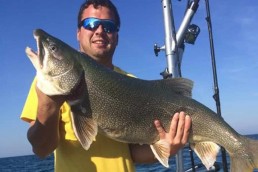In Search of Rainbow Trout
SHARE THIS POST
The Hoosier state offers a variety of species for anglers. From walleyes to largemouth bass and from bluegills to pike, fishermen can work a full tackle box and techniques to catch limit. But if it’s the fly rod that gets a person on the road, one should not overlook the rainbow trout. Although this species isn’t native to the state, the Indiana Department of Natural Resources (IDNR) makes quite a play in stocking this fish—some 30,000 strong. But in case you’ve never fished for rainbows before, keep in mind the following: keepers must be 18 inches or longer, with a limit of five. (Brown trout limit is one per day.)
Fishing for rainbow trout provides ample opportunity, of course, for anglers to hone their fly-tying skills, techniques and seasonal prowess. These fish are stocked by the IDNR in the spring throughout the state and most can survive in cooler waters. Furthermore, rainbows offer the type of challenge that many fishermen will enjoy.
But where to find them?
Here is a short list of the largest stock throughout the state, with all of the listings below representing at least a thousand fish.
• Elkhart County: Little Elkhart River and Solomon Creek
• Franklin County: Brookville Reservoir
• Greene County: Airline Pit and Midland Lake
• Henry County: Big Blue River
• LaGrange County: Little Elkhart River and Pigeon River
• Lake County: Fancher Lake
Are you enjoying this post?
You can be among the first to get the latest info on where to go, what to use and how to use it!
• LaPorte County: Little Kankakee River
• Steuben County: Clear Lake, Lake Gage and Pigeon River
• Tippecanoe County: Fairfield Pit Northeast
• Whitley County: Cedar Lake
Before heading out on a rainbow trout trip, make certain that your rod is cleaned and oiled. Check with your local tackle shop and secure a few new flies—or ask about the seasonal insects that might be attractive to rainbow in your area of the state. It’s fun to match wits with these fish, and learning the nuances of the larvae and lifecycles in the early summer months is one of the most intellectual pursuits of the sport.
Likewise, don’t forget that waders and a basket might come in handy when fishing for rainbows. If fishing for rainbows is a new venture you certainly don’t have to invest big money to have fun, but you can fund the basics for under $200.
Finally, in the event that you might enjoy a less strenuous or otherwise more relaxing attempt to secure some rainbows, try bank fishing with a simple hook and bobber (on fly rod). Secure corn niblets to a small hook (canned corn works very well) and cast a line into darker pools and rivulets where rainbow are likely to congregate—even in lakes and ponds. In these freshly stocked areas you are likely to get some action.
Of course, the best part of rainbow fishing is the eating—and with this species it doesn’t get any better, or simpler. Rainbows fillet very easily and freeze well in the event you catch your limit a few times this year. Enjoy this fish with boiled red potatoes, fresh corn on the cob, and a fine loaf of bread with butter and you’ll be hooked for life.
And don’t forget to check the Indiana Department of Natural Resources website for the latest details on the rainbow trout stockings, laws and availability.
MWO
SHARE THIS POST
Did you enjoy this post?
You can be among the first to get the latest info on where to go, what to use and how to use it!



